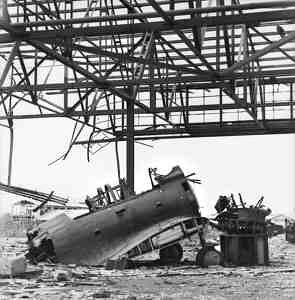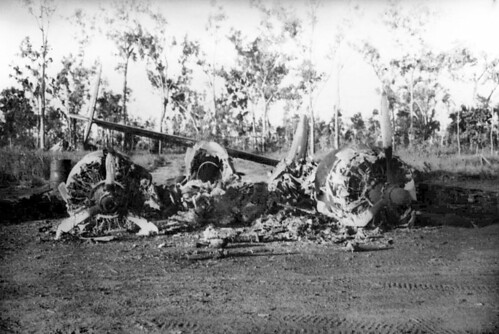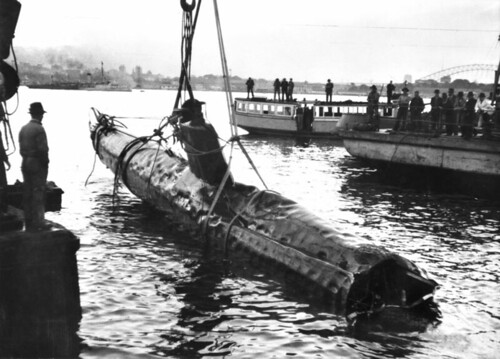 During World War II Darwin, the capital of Australia's Northern Territory, was a major port for the Australian Navy and a major base for the Australian Army. Darwin was used for repairs, re-supply and home for Australian commando units. Being so close to the Asia region, Darwin was considered a strategic location by both Australia and Japan.
During World War II Darwin, the capital of Australia's Northern Territory, was a major port for the Australian Navy and a major base for the Australian Army. Darwin was used for repairs, re-supply and home for Australian commando units. Being so close to the Asia region, Darwin was considered a strategic location by both Australia and Japan.On 19 February 1942 war finally came to Australia for the first time since white settlement.
A fleet of around 200 Japanese aircraft were despatched to attack Darwin from a point off the coast of Timor. Early that morning the aircraft passed over Bathurst Island and Catholic missionaries based there radioed Darwin to warn the Australian mainland. However, the Royal Australian Air Force (RAAF) refused to act on the advice believing the missionaries to be mistaken. As the formation began its run over the city the population went out to watch, thinking the planes were American.
Within minutes large amounts of high explosives began dropping from the sky. Japanese aircraft roared in over the town, attacking the harbour and the airfield.
 After the first attack, which had done most of its damage in the town and the harbour, a second wave swept in just before midday and concentrated on the airfield.
After the first attack, which had done most of its damage in the town and the harbour, a second wave swept in just before midday and concentrated on the airfield.Virtually unopposed, the attackers left Darwin almost completely decimated. The airfield was a disaster area with a large number of RAAF aircraft destroyed. In the harbour, Australian troopships had been sunk along with a number of cargo vessels. The death toll stood at 243, more than half of which had been on the ships in the harbour with 350 wounded.
Psychologically unprepared for attack, the population understandably panicked. The civilians took to the road in cars, trucks, motor cycles or on foot. There was even panic among servicemen.
 During the bombing numerous servicemen deserted their posts and took to the road with the civilians. In the town, once the fires had been stopped and the dead and injured attended to, a mood of relief was apparent.
During the bombing numerous servicemen deserted their posts and took to the road with the civilians. In the town, once the fires had been stopped and the dead and injured attended to, a mood of relief was apparent.Following the initial attack Darwin was bombed more than 60 times during the course of 1942 and 1943.
Darwin however, was not the only city that would come under attack by the Japanese.
 At sunset on Sunday 31 May 1942, there were five Japanese submarines positioned off the New South Wales coast near Sydney. Japanese mother submarines I-22, I-24, and I-27 launched midget submarines about 12kms east of Sydney. These midget submarines infiltrated Sydney Harbour and attempted to torpedo various warships anchored there. The other two submarines, I-21 and I-29, played a supporting role for the midget submarines.
At sunset on Sunday 31 May 1942, there were five Japanese submarines positioned off the New South Wales coast near Sydney. Japanese mother submarines I-22, I-24, and I-27 launched midget submarines about 12kms east of Sydney. These midget submarines infiltrated Sydney Harbour and attempted to torpedo various warships anchored there. The other two submarines, I-21 and I-29, played a supporting role for the midget submarines.Submarine I-21 later shelled Newcastle on 8 June 1942. On the same night Submarine 1-24 also shelled the eastern suburbs of Sydney.
Exercises:
On a new page in your books put the Heading “Australia Stands Alone”. Under the heading write a 1/2 page summary based upon the information above. After you have completed the summary, write the following sub-headings and the questions in your books and answer them in full sentences using the links to the websites listed below.
Air Raids
1. What did the army do in Darwin before the war?
2. When were air raid alerts first sounded?
Using Sources
1. Who is Mr Charles Abbott and what did he do?
2. What similarities does the writer of this article draw between this event and Pearl Harbour?
3. What was Bruce Acland quoted as saying?
Sydney Harbour
1. What was the primary target for the Japanese submarines?
2. What boat was sunk?
3. Take sometime to explore the rest of the site by watching the videos and animation.




 1:55 PM
1:55 PM
 Mark
Mark



0 comments:
Post a Comment